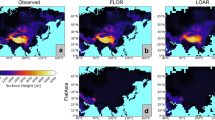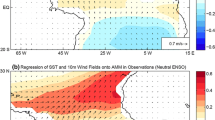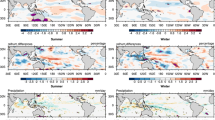Abstract
This study starts by investigating the impact of the configuration of the variable-resolution atmospheric grid on tropical cyclone (TC) activity. The French atmospheric general circulation model ARPEGE, the grid of which is rotated and stretched over the North Atlantic basin, was used with prescribed sea surface temperatures. The study clearly shows that changing the position of the stretching pole strongly modifies the representation of TC activity over the North Atlantic basin. A pole in the centre of the North Atlantic basin provides the best representation of the TC activity for this region. In a second part, the variable-resolution climate model ARPEGE is coupled with the European oceanic global climate model NEMO in order to study the impact of ocean–atmosphere coupling on TC activity over the North Atlantic basin. Two pre-industrial runs, a coupled simulation and a simulation forced by the sea surface temperatures from the coupled one, are compared. The results show that the coupled simulation is more active in the Caribbean Sea and the Gulf of Mexico while the forced simulation is more active over eastern Florida and the eastern Atlantic. The difference in the distribution of TC activity is certainly linked with the location of TC genesis. In the forced simulation, tropical cyclogenesis is closer to the west African coast than in the coupled simulation. Moreover, the difference in TC activity over the eastern Atlantic seems to be related to two different mechanisms: the difference in African easterly wave activity over the west of Africa and the cooling produced, in the coupled simulation, by African easterly waves over the eastern Atlantic. Finally, the last part studies the impact of changing the frequency of ocean–atmosphere coupling on Atlantic TC activity. Increasing the frequency of coupling decreases the density of TC activity over the North Atlantic basin. However, it does not modify the spatial distribution of the TC activity. TC rainfalls are decreased by 8 % in the high frequency coupled run.











Similar content being viewed by others
References
Arnault J, Roux F (2011) Characteristics of African easterly waves associated with tropical cyclogenesis in the Cape Verde Islands region in July-August-September of 2004-2008. J Atmos Res. doi:10.1016/J/atmosres.2010.12.028
Avila LA, Pasch RJ (1992) Atlantic tropical systems of 1991. Mon Weather Rev 120:2688–2696
Ayrault F, Joly A (2000) Une nouvelle topologie des dépressions météorologiques: classification des phases de maturation. CR Acad Sci Sci Terre planètes 30:167–172
Bender MA, Ginis I (2000) Real-case simulations of hurricane-ocean interaction using a high-resolution coupled model: effects on hurricane intensity. Mon Weather Rev 128:917–946
Bender MA, Ginis I, Kurihara Y (1993) Numerical simulations of tropical cyclone-ocean interaction with a high resolution coupled model. J Geophys Res 98:23245–23263
Bengtsson L, Bottger H, Kanamitsu M (1982) Simulation of hurricane-type vortices in a general circulation model. Tellus 34:440–457
Bengtsson L, Bozet M, Esh M (1995) Hurricane-type vortices in a general circulation model. Tellus 47A:175–196
Bernie D, Woolnough S, Slingo J (2005) Modeling diurnal and intraseasonal variability of the ocean mixed layer. J Clim 18:1190–1202
Bougeault P (1985) A simple parameterization of the large-scale effects of cumulus convection. Mon Weather Rev 113:2108–2121
Burpee RW (1972) The origin and structure of Easterly Waves in the lower troposphere of Nort Africa. J Atmos Sci 29:77–90
Camargo S, Zebiak S (2002) Improving the detection and tracking of tropical cylones in atmospheric general circulation models. Weather Forecast 17:1152–1162
Carlson T (1969) Synoptic histories of three African disturbances that developed into Atlantic hurricanes. Mon Weather Rev 97:256–276
Caron LP, Jones C, Winger K (2010) Impact of resolution and downscaling technique in simulating recent tropical cyclone activity. Clim Dyn. doi:10.1007/s00382-010-0846-7
Chang SW, Anthes RA (1978) Numerical simulations of the ocean’s nonlinear, baroclinic response to translating hurricanes. J Phys Oceanogr 8:468–480
Chauvin F, Royer JF, Déqué M (2006) Response of hurricane-type vortices to global warming as simulated by ARPEGE-Climat at high resolution. Clim Dyn 27:377–399
Courtier P, Geleyn JF (1988) A global numerical weather prediction mode with variable resolution: application to a shallow water equation. QJR Meteorol Soc 114:1321–1346
Daloz AS, Chauvin F, Walsh K, Lavender S, Abbs D, Roux F (2012) The ability of GCMs to simulate tropical cyclones and their precursors over the North Atlantic main development region. Clim Dyn. doi:10.1007/s00382-012-1290-7
Emanuel KA (1988) The maximum intensity of hurricanes. J Atmos Sci 45:1143–1155
Emanuel KA (2003) A similarity hypothesis of air-sea exchange at extreme wind speeds. J Atmos Sci 60:1420–1428
Emanuel KA (2005) Increasing destructiveness of tropical cyclones over the past 30 years. Nature 436:686–688
Fox-Rabinovitz M, Cote J, Dugas B, Deque M, McGregor JL (2006) Variable resolution general circulation models: stretched-grid model intercomparison project (SGMIP). J Geophys Res 111:D16104. doi:10.1029/2005JD006520
Goldenberg SB, Shapiro LJ (1996) Physical mechanisms for the association of the El Nino and the West African rainfall with the Atlantic major hurricane variability. J Clim 9:1169–1187
Holland GJ (1997) The maximum potential intensity of tropical cyclones. J Atmos Sci 54:2519–2541
Hopsch S, Thorncroft CD, Hodges K, Aiyyer A (2007) West African storm tracks and their relationship to Atlantic tropical cyclones. J Clim 20:2468–2483
Hsieh J-S, Cook KH (2005) Generation of African Easterly Wave disturbances: relationship to the African Easterly Jet. Mon Weather Rev 133:1311–1327
Kanamitsu M, Ebisuzaki W, Woolen J, Hnilo J, Fiorino L et al (2002) NCEP-DOE AMIP-II reanalysis (R-2). Bull Am Meteorol Soc 83:1631–1643
Klingaman N, Woolnough S, Weller H, Slingo J (2011) The impact of finer-resolution air-sea coupling on the intraseasonal oscillation of the Indian monsoon. J Clim 24(10):2451–2468
Knapp KR, Kruk MC, Levinson DH, Diamond HJ, Neumann CJ (2010) The International Best Track Archive for Climate Stewardship (IBTrACS): unifying tropical cyclone best track data. Bull Am Meteorol Soc 91:363–376
Landsea CW (1993) A climatology of intense (or major) Atlantic hurricanes. Mon Weather Rev 121:1703–1713
Landsea CW, Gray W (1992) The strong association between western Sahelian monsoon rainfall and intense Atlantic hurricanes. J Clim 5:435–453
Lebeaupin-Brossier C, Ducrocq V, Giordani H (2009) Effects of air-sea coupling time frequency on the ocean response during Mediterranean intense events. Ocean Dyn 54(4):539–549
Lin I-L, Liu WT, Wu C–C, Chiang JCH, Sui C-H (2003) Satellite observations of modulation of surface winds by typhoon-induced upper ocean cooling. Geophys Res Lett 30(3):1131. doi:10.1029/2002GL015674
Madec G (2008) NEMO ocean engine. Note du pôle modélisation, Institut Pierre-Simon Laplace (IPSL), France, No 27 ISSN 1288-1619
Malkus JS, Riehl H (1960) On the dynamics and energy transformation in steady-state hurricanes. Tellus 12:1–20
Mlawer EJ, Taubman SJ, Brown PD, Iacono MJ, Clough SA (1997) Radiative transfer for inhomogeneous atmosphere: RRTM, a validated correlated-k model for longwave. J Geophys Res 102:16663–16682
Murakami H, Wang B (2010) Future change of North Atlantic tropical cyclone tracks: projection by a 20-km-mesh global atmospheric model. J Clim 23:2699–2721
Oki T, Sud YC (1998) Design of total runoff integrating pathways (TRIP). A global river channel network. Earth Interact 2:1–36
Price JF (1981) Upper ocean response to a hurricane. J Phys Oceanogr 11:153–175
Price JF, Morzel J, Niiler PP (2008) Warming of SST in the cold wake of a moving hurricane. J Geophys Res 113. doi:10.1029/2007JC004393
Rayner NA, Parker DE, Horton EB, Folland CK, Alexander LV, Rowell DP, Kent EC, Kaplan A (2003) Global analyses of SST, sea ice and night marine air temperature since the late nineteenth century. J Geophys Res 108:4407. doi:10.1029/2002JD002670
Reed RJ, Norquist DC, Recker EE (1977) The structure and properties of African wave disturbances as observed during phase III of GATE. Mon Weather Rev 105:317–333
Renaudie C (2009) Etude et validation des couches limites atmospheriques et oceanique a l echelle locale. PhD, University of Toulouse, France
Ricard JL, Royer JF (1993) A statistical cloud scheme for use in an AGCM. Ann Geophys 11:1095–1115
Royer JF, Chauvin F, Timbal B, Araspin P, Grimal D (1998) A GCM study of the impact of greenhouse gas increase on the frequency of occurrence of tropical cyclones. Clim Change 38:307–343
Ruti PM, Dell Aquilla A (2010) The twentieth century African easterly waves in reanalysis systemes and IPCC simulations, from intra-seasonal to inter-annual variability. Clim Dyn 35:1099–1117
Salas-Mélia D (2002) A global coupled sea ice-ocean model. Ocean Model 4:137–172
Samson G, Giordani H, Caniaux G (2009) Numerical investigation of oceanic resonant regime induced by hurricane winds. Ocean Dyn 59:565–586
Schade L, Emanuel K (1999) The ocean’s effect on the intensity of tropical cyclones: results from a simple coupled atmosphere-ocean model. J Atmos Sci 56:642–651
Schultz M (2007) Constraining model estimates of the aerosol radiative forcing. Habilitation thesis, Université Pierre et Marie Curie
Szopa S, Cozic A, Schulz M, Balkanski Y, Hanglustaine (2012) Changes in tropospheric aerosol and reactive gas burdens and concentrations under IPCC-AR5 emission scenarios for 1850-2100. Clim Dyn, Special issue on the IPSL and CNRM global climate and Earth System Models
Uppala S, Kallberg P, Simmons U, Jand A, Betchold V, Fiorino M et al (2005) The ERA-40 reanalysis. QJR Meteorol Soc 131:2961–3012
Valcke S (2006) OASIS3 user guide (prism 2-5). Technical report TR/CMCG/06/73, CERFACS, Toulouse, France, p 60
Voldoire A, Cassou C, Salas-Mélia D, Decharme B, Sanchez-Gomez E, Sénési S, Valcke S, Beau I, Alias A, Chevallier M, Déqué M, Douville H, Maisonnave E, Planton S, Saint-Martin D, Tyteca S, Alkama R, Belamari S, Braun A, Chauvin F, Szopa S (2011) The CNRM-CM5.1 global climate model description and basic evolution. Clim Dyn. doi:10.1007/s00382-011-1259-y
Acknowledgments
Thanks to the two reviewers for insightful comments on this work. The authors would like to thank Aurelien Ribes for the statistical advices. The authors are also grateful for the availability of IBTrACS, ERA-40 and NCEP-2 reanalysis.
Author information
Authors and Affiliations
Corresponding author
Rights and permissions
About this article
Cite this article
Daloz, A.S., Chauvin, F. & Roux, F. Impact of the configuration of stretching and ocean–atmosphere coupling on tropical cyclone activity in the variable-resolution GCM ARPEGE. Clim Dyn 39, 2343–2359 (2012). https://doi.org/10.1007/s00382-012-1561-3
Received:
Accepted:
Published:
Issue Date:
DOI: https://doi.org/10.1007/s00382-012-1561-3




